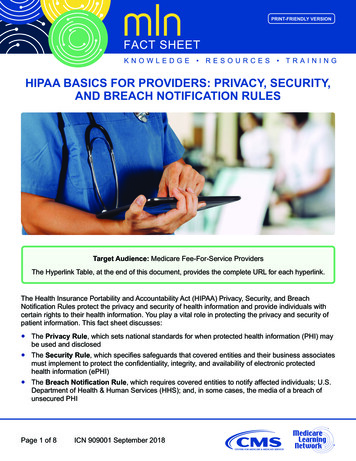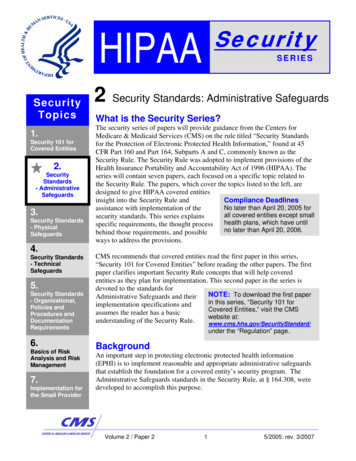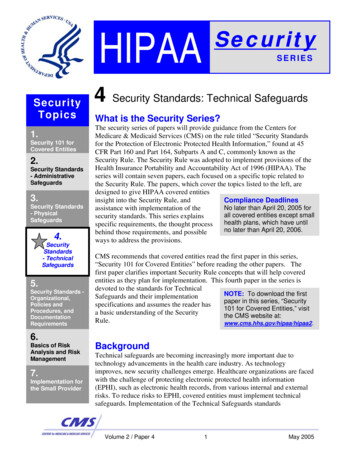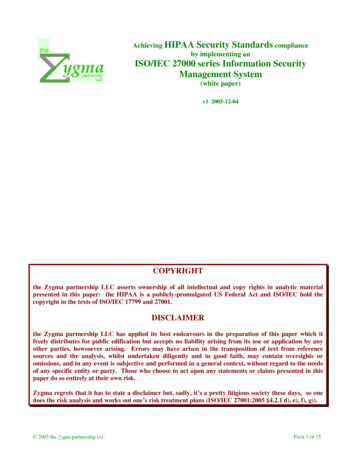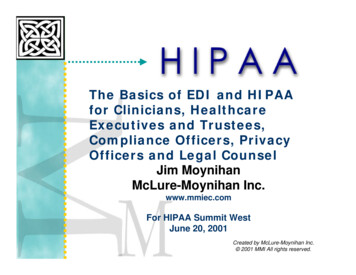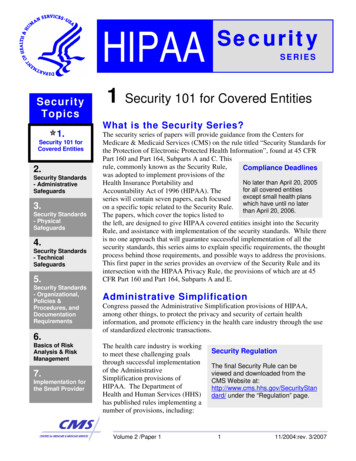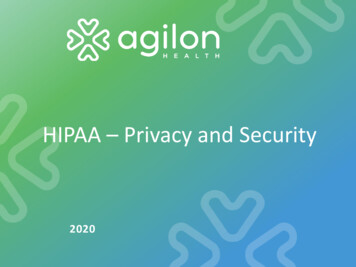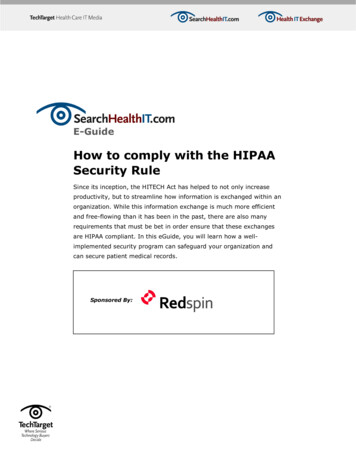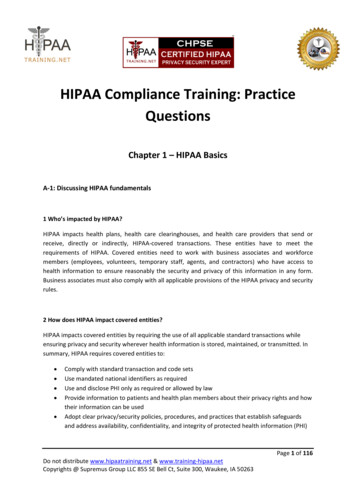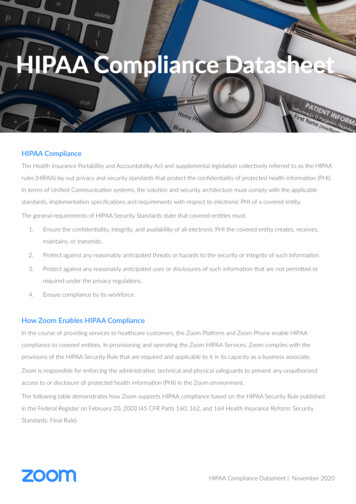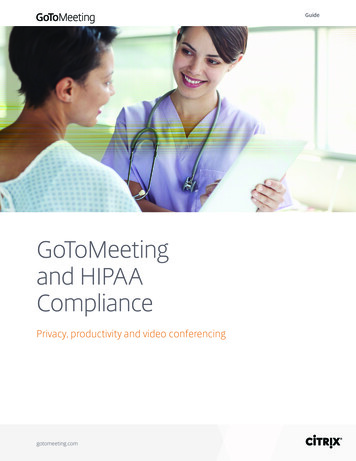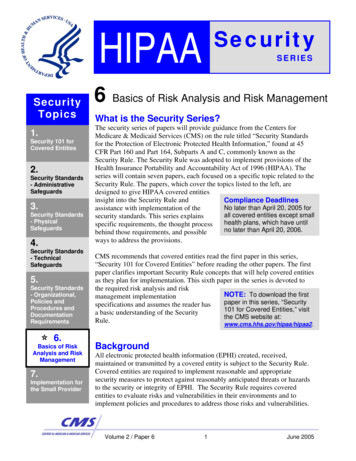
Transcription
SecurityHIPAASecurityTopics1.Security 101 forCovered Entities2.Security Standards- AdministrativeSafeguards3.Security Standards- PhysicalSafeguards4.Security Standards- TechnicalSafeguards5.Security Standards- Organizational,Policies andProcedures andDocumentationRequirements6.Basics of RiskAnalysis and RiskManagement7.Implementation forthe Small ProviderSERIES6 Basics of Risk Analysis and Risk ManagementWhat is the Security Series?The security series of papers will provide guidance from the Centers forMedicare & Medicaid Services (CMS) on the rule titled “Security Standardsfor the Protection of Electronic Protected Health Information,” found at 45CFR Part 160 and Part 164, Subparts A and C, commonly known as theSecurity Rule. The Security Rule was adopted to implement provisions of theHealth Insurance Portability and Accountability Act of 1996 (HIPAA). Theseries will contain seven papers, each focused on a specific topic related to theSecurity Rule. The papers, which cover the topics listed to the left, aredesigned to give HIPAA covered entitiesinsight into the Security Rule andCompliance DeadlinesNo later than April 20, 2005 forassistance with implementation of theall covered entities except smallsecurity standards. This series explainshealth plans, which have untilspecific requirements, the thought processno later than April 20, 2006.behind those requirements, and possibleways to address the provisions.CMS recommends that covered entities read the first paper in this series,“Security 101 for Covered Entities” before reading the other papers. The firstpaper clarifies important Security Rule concepts that will help covered entitiesas they plan for implementation. This sixth paper in the series is devoted tothe required risk analysis and riskNOTE: To download the firstmanagement implementationpaper in this series, “Securityspecifications and assumes the reader has101 for Covered Entities,” visita basic understanding of the Securitythe CMS website at:Rule.www.cms.hhs.gov/hipaa/hipaa2.BackgroundAll electronic protected health information (EPHI) created, received,maintained or transmitted by a covered entity is subject to the Security Rule.Covered entities are required to implement reasonable and appropriatesecurity measures to protect against reasonably anticipated threats or hazardsto the security or integrity of EPHI. The Security Rule requires coveredentities to evaluate risks and vulnerabilities in their environments and toimplement policies and procedures to address those risks and vulnerabilities.Volume 2 / Paper 61June 2005
6 Basics of Risk Analysis and Risk ManagementHIPAA SECURITYSTANDARDSSecurity Standards:General Rules---ADMINISTRATIVESAFEGUARDSSecurity ManagementProcessAssigned SecurityResponsibilityWorkforce SecurityInformation AccessManagementSecurity Awarenessand TrainingSecurity IncidentProceduresContingency PlanEvaluationBusiness AssociateContracts and OtherArrangementsPHYSICALSAFEGUARDSFacility AccessControlsWorkstation UseWorkstation SecurityDevice and MediaControlsTECHNICALSAFEGUARDSAccess ControlSTANDARDAudit ControlsIntegrity164.310(a)(1)Person or EntityAuthenticationTransmission SecurityORGANIZATIONALREQUIREMENTS- Business AssociateContracts and OtherArrangements- Requirements forGroup Health PlansPOLICIES andPROCEDURES andDOCUMENTATIONREQUIREMENTSThe objectives of this paper are to: Review the Security Rule required implementation specificationsfor Risk Analysis and Risk Management. Review the basic concepts involved in security risk analysis andrisk management. Discuss the general steps involved in risk analysis and riskmanagement.Security Rule Requirements for Risk Analysisand Risk ManagementThe Security Management Process standard, at § 164.308(a)(1)(i)) in theAdministrative Safeguards section of the Security Rule, requires coveredentities to “[i]mplement policies and procedures to prevent, detect, contain,and correct security violations.” The Security Management Processstandard has four required implementation specifications. Two of theimplementation specifications are Risk Analysis and Risk Management.The required implementation specification at § 164.308(a)(1)(ii)(A), forRisk Analysis, requires a covered entity to, “[c]onduct an accurate andthorough assessment of the potential risks and vulnerabilities to theconfidentiality, integrity, and availability of electronic protected healthinformation held by the covered entity.”The required implementation specification at § 164.308(a)(1)(ii)(B), forRisk Management, requires a covered entity to “[i]mplement securitymeasures sufficient to reduce risks and vulnerabilities to a reasonable andappropriate level to comply with § 164.306(a) [(the General Requirementsof the Security Rule)].”Both risk analysis and risk management are standard information securityprocesses and are critical to a covered entity’s Security Rule complianceefforts. As stated in the responses toNOTE: Risk analysis and riskpublic comment in the preamble to themanagement serve as tools toSecurity Rule, risk analysis and riskdevelop and maintain a coveredmanagement are important to coveredentity’s strategy to protect theentities since these processes will “formconfidentiality, integrity, andthe foundation upon which an entity’savailability of EPHI.Volume 2 / Paper 62June 2005
6 Basics of Risk Analysis and Risk Managementnecessary security activities are built.” (68 Fed. Reg. 8346.)Much of the content included in this paper is adapted from government resources such as theNational Institute of Standards and Technology (NIST) 800 Series of Special Publications (SP),specifically, SP 800-30 - Risk Management Guide for Information Technology Systems. Thesegovernment resources are freely available in the public domain.Although only federal agencies are required to follow federal guidelines like the NIST 800series, non-federal covered entities may find their content valuable when performing complianceactivities. As stated in the CMS frequently asked questions (FAQs) on the HIPAA Security Rule,“Covered entities may use any of the NIST documents to the extent that they provide relevantguidance to that organization’s implementation activities. While NIST documents werereferenced in the preamble to the Security Rule, this does not make them required. In fact, someof the documents may not be relevant to small organizations, as they were intended more forlarge, governmental organizations.”The Security Rule does not prescribe a specific risk analysis or risk management methodology.This paper is not intended to be the definitive guidance on risk analysis and risk management.Rather, the goal of this paper is to present the main concepts of the risk analysis and riskmanagement processes in an easy-to-understand manner. Performing risk analysis and riskmanagement can be difficult due to the levels of detail and variations that are possible withindifferent covered entities. Covered entities should focus on the overall concepts and stepspresented in this paper to tailor an approach to the specific circumstances of their organization.Important Definitions to UnderstandTo better understand risk analysis and risk managementNOTE: A risk analysis willprocesses, covered entities should be familiar with severalidentify potential threats to andimportant terms, including “vulnerability,” “threat,” andvulnerabilities of information“risk,” and the relationship between the three terms. Thesesystems and the associatedterms are not specifically defined in the Security Rule. Therisk.definitions in this paper are provided to put the Risk Analysisand Risk Management discussion in context. These definitions do not modify or update theSecurity Rule and are not inconsistent with the terms used in the Security Rule. Rather, thefollowing definitions are consistent with common industry definitions and are from documentedsources, such as NIST SP 800-30. Explanations of the terms are adapted from NIST SP 800-30and are presented in the context of the Security Rule.VULNERABILITYVulnerability is defined in NIST SP 800-30 as “[a] flaw or weakness in system securityprocedures, design, implementation, or internal controls that could be exercisedVolume 2 / Paper 63June 2005
6 Basics of Risk Analysis and Risk Management(accidentally triggered or intentionally exploited) and result in a security breach or aviolation of the system’s security policy.”Vulnerabilities, whether accidentally triggered or intentionally exploited, couldpotentially result in a security incident, such as an inappropriate use or disclosure ofEPHI. Vulnerabilities may be grouped into two general categories, technical and nontechnical. Non-technical vulnerabilities may include ineffective or non-existent policies,procedures, standards or guidelines. Technical vulnerabilities may include: holes, flawsor weaknesses in the development of information systems; or incorrectly implementedand/or configured information systems.THREATAn adapted definition of threat, from NIST SP 800-30, is “[t]he potential for a person orthing to exercise (accidentally trigger or intentionally exploit) a specific vulnerability.”There are several types of threats that may occur within an information system oroperating environment. Threats may be grouped into general categories such as natural,human, and environmental. Examples of common threats in each of these generalcategories include: Natural threats may include floods, earthquakes, tornadoes, and landslides. Human threats are enabled or caused by humans and may include intentional(e.g., network and computer based attacks, malicious software upload, andunauthorized access to EPHI) or unintentional (e.g., inadvertent data entry ordeletion and inaccurate data entry) actions. Environmental threats may include power failures, pollution, chemicals, andliquid leakage.RISKThe definition of risk is clearer once threat and vulnerability are defined. An adapteddefinition of risk, from NIST SP 800-30, is:“The net mission impact considering (1) theNOTE: A Vulnerabilityprobability that a particular [threat] willtriggered or exploited by aexercise (accidentally trigger or intentionallyThreat equals a Risk.exploit) a particular [vulnerability] and (2)the resulting impact if this should occur. [R]isks arise from legal liability or mission loss due to—Volume 2 / Paper 64June 2005
6 Basics of Risk Analysis and Risk Management1. Unauthorized (malicious or accidental) disclosure, modification, ordestruction of information2. Unintentional errors and omissions3. IT disruptions due to natural or man-made disasters4. Failure to exercise due care and diligence in the implementation andoperation of the IT system.”Risk is a function of 1) the likelihood of a given threat triggering or exploiting aparticular vulnerability, and 2) the resulting impact onNOTE: A threat must have thethe organization. This means that risk is not a singlecapability to trigger or exploit afactor or event, but rather it is a combination ofvulnerability to create risk.factors or events (threats and vulnerabilities) that, ifthey occur, may have an adverse impact on theorganization.Example Risk Analysis and Risk Management StepsThere are numerous methods of performing risk analysis and risk management. There is nosingle method or “best practice” that guarantees compliance with the Security Rule. However,most risk analysis and risk management processes have common steps. The following steps areprovided as examples of steps covered entities could apply to their environment. The steps areadapted from the approach outlined in NIST SP 800-30.EXAMPLE RISK ANALYSIS STEPS:1. Identify the scope of the analysis.NOTE: CMS is not2. Gather data.recommending that all covered3. Identify and document potential threatsentities follow this approach, butrather is providing it as a frameand vulnerabilities.of reference.4. Assess current security measures.5. Determine the likelihood of threatoccurrence.6. Determine the potential impact of threat occurrence.7. Determine the level of risk.8. Identify security measures and finalize documentation.EXAMPLE RISK MANAGEMENT STEPS:1. Develop and implement a risk management plan.2. Implement security measures.3. Evaluate and maintain security measures.Volume 2 / Paper 65June 2005
6 Basics of Risk Analysis and Risk ManagementWhen the following example risk analysis and risk management approaches contain actions thatare required for compliance with the Security Rule, such as documentation, appropriate languageand citations are used to highlight the Security Rule requirement. For example, the statementwithin these example approaches that a covered entity “must document” a certain action is areference to the requirements of § 164.316(b)(1)(ii), the Documentation standard. These exampleapproaches indicate that a covered entity “must” or “should” perform certain actions, as requiredby the Security Rule, but do not require a covered entity to meet the requirements only by usingthe methods, steps, or actions identified in the example approaches.Example Risk Analysis StepsAs previously stated, the Security Rule requires covered entities to conduct an accurate andthorough risk analysis. This section of the paper provides an example approach to risk analysiswhich may be used by covered entities.1. Identify the Scope of the AnalysisRisk analysis is not a concept exclusive to the healthcare industry or the Security Rule.Risk analysis is performed using different methods and scopes. The risk analysis scopethat the Security Rule requires is the potential risks and vulnerabilities to theconfidentiality, availability and integrity of all EPHI that a covered entity creates,receives, maintains, or transmits. This includes EPHI in all forms of electronic media.Electronic media is defined in § 160.103, as:“(1) Electronic storage media including memory devices in computers(hard drives) and any removable/transportable digital memory medium,such as magnetic tape or disk, optical disk, orExamples of Electronicdigital memory card; or (2) TransmissionMedia with EPHI:media used to exchange information alreadyHard drives, Floppy Disks, CDs,in electronic storage media. TransmissionDVDs, Smart Cards, Personalmedia include, for example, the internetDigital Assistants (PDA),(wide-open), extranet (using internetTransmission Media, ortechnology to link a business with informationPortable Electronic Storageaccessible only to collaborating parties),Media.leased lines, dial-up lines, private networks,and the physical movement of removable/transportable electronic storagemedia. Certain transmissions, including of paper, via facsimile, and ofvoice, via telephone, are not considered to be transmissions via electronicmedia, because the information being exchanged did not exist inelectronic form before the transmission.”Electronic media could range from a single workstation to complex communicationsnetworks connected between multiple locations. Thus, a covered entity’s risk analysisVolume 2 / Paper 66June 2005
6 Basics of Risk Analysis and Risk Managementshould take into account all of its EPHI, regardless of the particular electronic medium inwhich it is created, received, maintained or transmitted or the source or location of itsEPHI.2. Gather DataOnce the scope of the risk analysis is identified, the covered entity should gather relevantdata on EPHI. For example, a covered entity must identify where the EPHI is stored,received, maintained or transmitted. A covered entity could gather relevant data by:reviewing past and/or existing projects; performing interviews; reviewing documentation;or using other data gathering techniques. The data on EPHI gathered using these methodsmust be documented. (See §§ 164.308(a)(1)(ii)(A) and 164.316(b)(1).)Many covered entities inventoried and performed an analysis of the use and disclosure ofall protected health information (PHI) (which includes EPHI) as part of HIPAA PrivacyRule compliance, even though it was not a direct requirement. This type of inventory andanalysis is a valuable input for the risk analysis.The level of effort and resource commitment needed to complete the data gathering stepdepends on the covered entity’s environment and amount of EPHI held. For example, asmall provider that keeps its medical records on paper may be able to identify all EPHIwithin the organization by analyzing a single department which uses an informationsystem to perform billing functions. In another covered entity with large amounts ofEPHI, such as a health system, identification of all EPHI may require reviews of multiplephysical locations, most (if not all) departments, multiple information systems, portableelectronic media, and exchanges between business associates and vendors.3. Identify and Document Potential Threats andVulnerabilitiesOnce the covered entity has gathered and documented relevant data on EPHI, the nextstep is to identify potential threats and vulnerabilities to the confidentiality, availabilityand integrity of the EPHI. As discussed earlier, the potential for a threat to trigger orexploit a specific vulnerability creates risk. Therefore, identification of threats andvulnerabilities are central to determining the level of risk.The identification of threats and vulnerabilities could be separated into two distinct stepsbut are so closely related in the risk analysis process that they should be identified at thesame time. Independent identification may result in large lists of threats andvulnerabilities that, when analyzed (in subsequent steps to identify risk), do not providevaluable information.Volume 2 / Paper 67June 2005
6 Basics of Risk Analysis and Risk ManagementIDENTIFY AND DOCUMENT THREATSCovered entities must identify and document reasonably anticipated threats toEPHI. (See §§ 164.306(a)(2) and 164.316(b)(1)(ii).) To start, covered entities maycompile a categorized list (such as natural, human, and environmental) of threats.Covered entities may identify different threats unique to the circumstances oftheir environment.After the complete list is compiled, theNOTE: A covered entity shouldcovered entity should reduce the list to onlyfocus its list of threats to thosethose reasonably anticipated threats. This canthat are reasonably anticipated.be done by focusing on specific characteristicsof the entity in relation to each of the threatcategories. For example, the geographic location of the entity will determine thenatural threats that may create a risk. A hurricane is a threat, but a covered entityin Kansas probably would not consider it a reasonably anticipated threat due to itslocation. However, a covered entity in Kansas should consider the likelihood of atornado a reasonably anticipated threat.For most covered entities, human threats will be of greatest concern, becausehuman threats have the potential to be triggered or exploited more frequently thannatural or environmental threats. Potential human sources that could target acovered entity and trigger or exploit vulnerabilities are employees (the mostcommon source), ex-employees, hackers, commercial rivals, terrorists, criminals,general public, vendors, customers and visitors. Anyone that has the access,knowledge and/or motivation to cause an adverse impact on the covered entitycan act as a threat.Covered entities should analyze several information sources to help identifypotential human threats to their systems. Information sources such as any historyof system break-ins, security violation reports, and ongoing input from systemsadministrators, help desk personnel and the user community should be reviewed.IDENTIFY AND DOCUMENT VULNERABILITIESWhile identifying potential threats, covered entities must also identify anddocument vulnerabilities which, if triggered or exploited by a threat, would createa risk to EPHI. (See §§ 164.308(a)(1)(ii)(A) and 164.316(b)(1)(ii).) The processof identifying vulnerabilities is similar to the process used for identifying threats.The entit
HIPAA Security SERIES Compliance Deadlines No later than April 20, 2005 for all covered entities except small health plans, which have until no later than April 20, 2006. NOTE:- Organi To download the first paper in this se
